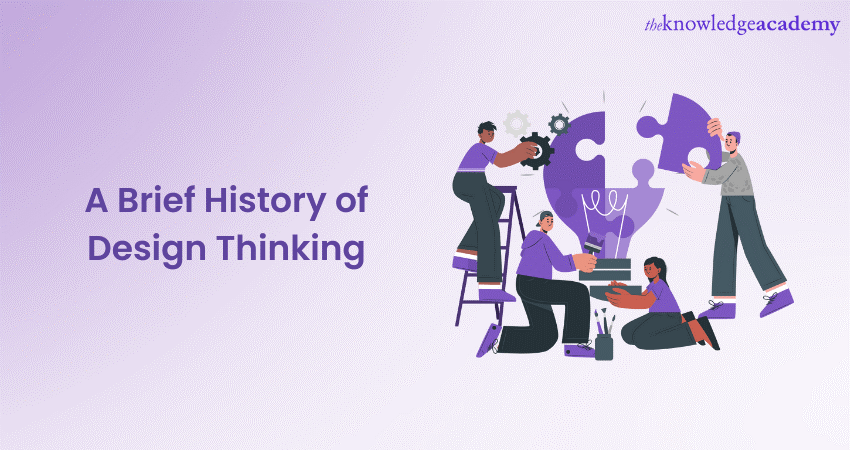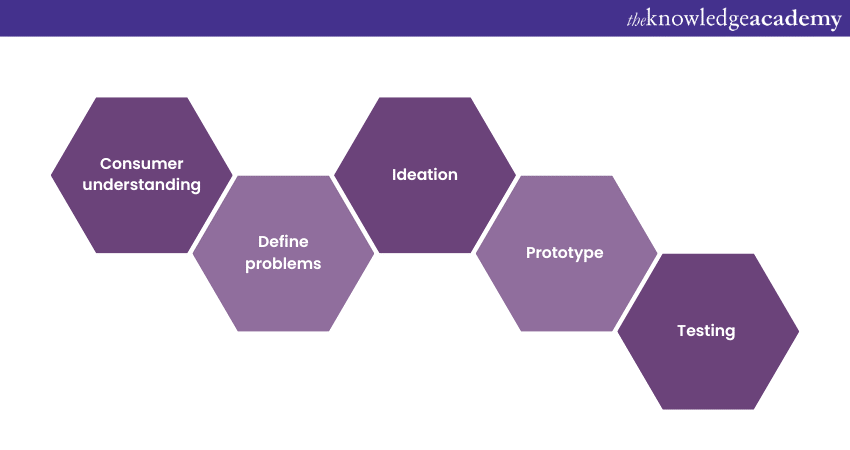We may not have the course you’re looking for. If you enquire or give us a call on 01344203999 and speak to our training experts, we may still be able to help with your training requirements.
Training Outcomes Within Your Budget!
We ensure quality, budget-alignment, and timely delivery by our expert instructors.

The History of Design Thinking traces its origins back to the mid-20th century when academics and practitioners began to examine the creative strategies employed by designers. Rooted in architecture and industrial design, these strategies evolved into a systematic approach known as Design Thinking. This method prioritises empathy, collaboration, and experimentation in problem-solving.
Over the decades, it has transcended its original fields, influencing the business, technology, and education sectors. This evolution underscores the adaptability and relevance of Design Thinking. Read this blog to learn about the History of Design Thinking, its timeline, process, reasons for its popularity, and its future.
Table of Contents
1) The roots of Design Thinking
2) Timeline of Design Thinking
a) The early attempts
b) Industrial Revolution and Design Thinking
c) Modernisation and Design Thinking
d) Design Thinking and globalisation
3) Process of Design Thinking
a) Consumer understanding
b) Define problems
c) Ideation
d) Prototype
e) Testing
4) Why is it so popular?
a) Think out of the box
5) Future of Design Thinking
6) Conclusion
The roots of Design Thinking
The early insights of Design Thinking date back to the early 50s and 60s when people started studying Design Reasoning and Design Methodology. However, these are often associated with the context of ancient architecture and engineering, which were limited to implementing complex scientific ideas into practical life.
Design Thinking is much more than just a process; it is a mindset that encourages the relentless pursuit of understanding, creativity, and innovation. By placing human needs at the heart of the problem-solving journey, Design Thinking empowers individuals and teams to generate transformative solutions that have a lasting impact on society.
Even though it is nearly impossible to figure out all the aspects that led to the birth of Design Theory and how it functions, it is widely believed that strategic thinking took a giant leap after the Second World War.
Timeline of Design Thinking
Let's understand the timeline of Design Thinking.
1960s
In the 1960s, designers applied scientific methodology to understand design functions and influences. Nigel Cross's paper explores the struggle between design discipline and design science, aiming to make design scientific and rational.
In the early days, it was known as participatory methodology. Before the label was given to this method by subsequent innovations in design, it was primarily used in urban planning and designing.
1970s
Herbert A. Simon, a Nobel Prize laureate, introduced design as a 'way of thinking' in his book, The Sciences of the Artificial. He introduced Design Thinking principles, including rapid prototyping and observation, which are core to modern design and entrepreneurial processes.
As participatory methodology developed throughout the 70s, it grew to be considered an interdisciplinary interaction design language. Science has inspired many methods in participatory design, such as usability testing across the departments, including role-playing, prototyping and mock-ups.
1980s
In 1982, Nigel Cross's "Designerly Ways of Knowing" paper compared designers' problem-solving processes to non-design-related solutions in everyday life. Brian Lawson, Emeritus Professor at the University of Sheffield, discussed insights from tests comparing methods scientists and architects use to solve ambiguous problems.
1990s
IDEO, a global design and innovation company, introduced Design Thinking to the mainstream, creating customer-friendly terminology and toolkits. Richard Buchanan, Head of Design at Carnegie Mellon University, discusses its origins and how sciences evolved into specialisations. Design Thinking integrates specialised fields of knowledge to address global problems from a holistic perspective.
2000s
David Kelley founded Stanford's Hasso Plattner Institute of Design, which focuses on Design Thinking development and implementation. The Design Thinking movement was rapidly gaining ground, with pioneers like IDEO and the design schools paving the way for others. Universities, business schools, and companies have adopted the methodology, sometimes re-interpreting it to suit their context or brand values.
Present day
The Industrial Revolution and World War II both stretched our understanding of what was technologically feasible. Due to the immense social changes at the time, engineers, architects, industrial designers, and cognitive scientists started to focus their research on problem-solving.
From the 50s and 60s onward, Design Thinking emerged, or perhaps, converted the technique by infusing the period's strategic, technological, and human needs. It evolved gradually over five decades only to become the prominent innovation methodology of modern times.
It keeps on exploding and enriching by those at the front end contributing to the research and development. Design Thinking is still being improved by people at the forefront of research and development and is gaining ground across many industries.
Try our new Design Thinking for Business Strategy course for a successful career!
The early attempts
Nigel Cross, a professor of Design Studies at the Open University, UK, filed a paper on “Designerly Ways of Knowing: Design Discipline versus Design Science”. However, the scuffle persisted over the decade, and many more attempts were made to clarify the goals of logical and scientific approaches to make Design Thinking well organised.
Industrial Revolution and Design Thinking
The Industrial Revolution brought about a profound transformation in the manufacturing industry. Industrialists in the United Kingdom started to embody Design Thinking principles in their revolutionary creations. Pioneers like Henry Ford embraced Design Thinking to bridge the gap between efficiency and human needs.
Modernisation and Design Thinking
The early 20th century witnessed the establishment of design schools and the emergence of the modernist movement. This led to exploring new ideas and bringing them to life. These design schools shaped the Design Thinking methodologies with the help of UI and UX design learning, which would not only endure the test of time but also provide us with a better understanding of human needs, motivation and behaviour patterns.
Design Thinking and globalisation
Post-globalisation Design Thinking took a new dimension, focusing on social change and improving the quality of human life. The influence of design has been on organisations across all sectors of the economy. Designing turned out to help manage product development even in the era of AI and ML.
Process of Design Thinking
In this era, Design Thinking began to solidify into a defined process. We witnessed how design consultancy firms pioneered this shift, introducing a methodology that encouraged cross-disciplinary collaboration and rapid prototyping by implementing all its processes into action without fear of rejection. This fosters an environment where the most groundbreaking solutions can emerge, often stemming from one of these stages.

Consumer understanding
The first rule of business is to design great products in terms of user-friendliness. Therefore, it is essential to deeply understand the consumer’s attitudes, needs, attributes and other emotions. It is necessary to consider all behavioural and cultural aspects to get to the root cause of the problem before proceeding further. Stepping into customers' shoes, empathising with them, and paying attention to nuances helps a great deal in strategies for product designing.
Define problems
Once armed with a wealth of user insight, the Design Thinker crosses the barrier and begins to think of defining the appropriate solution. By precisely representing the problem, organisations can save many recourses and unlock the best solutions after outlining all the challenges and opportunities.
Ideation
The magic happens in the ideation stage after understanding the customers' needs. Design Thinkers leave no stone unturned to implement these ideas into reality, including brainstorming sessions involving diverse perspectives combined with S.W.O.T. analysis (strengths, weaknesses, opportunities, threats) and interdisciplinary collaboration to leverage our combined intelligence.
Prototype
Prototyping is the stage where ideas transformed into tangible concepts. At this stage Design Thinker applies trial and error technique to identify any shortcoming, consumer gaps and barrier. Prototyping facilitates invaluable feedback lops with users, enabling designers to gauge reactions and identify areas of improvement. The iterative nature of prototyping enables constant refinement, steering the design towards gather alignment with user needs.
Testing
This is the final stage of Design Thinking, where prototypes are tested with real users. This step allows designers to validate their assumptions and make data-driven decisions. Users' feedback helps designers understand how their solutions resonate in the real world and guides them in further refining the product or services.
By embracing failure as a learning curve, Design Engineers can iterate and improve their concepts based on user insight. This perpetual cycle of prototyping and testing fosters a culture of adaptability and continuous improvement.
Learn more about Design Thinking with our Design Thinking Training!
Why is it so popular?
In a world driven by rapid technological advancement and ever-changing consumer demands, traditional ways of problem-solving will no longer serve the purpose of organisations. Rooted in creativity, empathy, and innovation, Design Thinking has become the driving force behind many successful products and services that have recently captured our minds and market.
Design Thinking gives us real-world scenarios to identify patterns, emotions and frustrations that may go unnoticed on the surface. By adopting this empathetic mindset, designers can think out of the box, connect deeper with their users, and create solutions that resonate on a profound level, unlocking the avenues of creativity. It also helps organisations conduct the proper research, develop prototypes and test their products and services to unleash new ways to satisfy users' needs.
Future of Design Thinking
Design Thinking is a part of creative thinking and problem-solving. Many people believe that Design Thinking is only for designers. However, that is not true. Anyone who wants to be more creative and innovative can use Design Thinking as a tool.
Modern science and rapid technological changes can turn around the future of Design Thinking. It will continue to evolve and be used across different domains to create new products and services with an enriched user experience.
All facets of the economies and industries across domains have embraced Design Thinking. But software development, where the destination may be unclear at first and tweaks are frequently needed, is where it finds its most significant application. This unconventional method of producing creative products works more effectively when addressing vague and unidentified difficulties. These stages are a journey towards an objective rather than being inherently hierarchical or linear. Despite being relatively new to the business, designers have always used this approach naturally.
Integrating Artificial Intelligence and Machine Learning can unlock new avenues for Design Thinkers. The future of Design Thinking lies in its capacity to help people solve even more complex problems in the best creative way possible. As problems in the world become more complex, there will be a need for people who can think outside the box.
Conclusion
As we conclude our journey through the History of Design Thinking, we are reminded of its timeless relevance and boundless potential. From ancient innovations to the global phenomenon, Design Thinking has continuously adapted to meet the needs of humanity. As we embrace the future, we carry the wisdom of the past, using Design Thinking to forge a path towards a more empathetic and innovative world.
Frequently Asked Questions
Upcoming Business Skills Resources Batches & Dates
Date
 Successful People Management and Team Leadership
Successful People Management and Team Leadership
Fri 14th Feb 2025
Fri 16th May 2025
Fri 25th Jul 2025
Fri 29th Aug 2025
Fri 10th Oct 2025
Fri 28th Nov 2025







 Top Rated Course
Top Rated Course



 If you wish to make any changes to your course, please
If you wish to make any changes to your course, please


